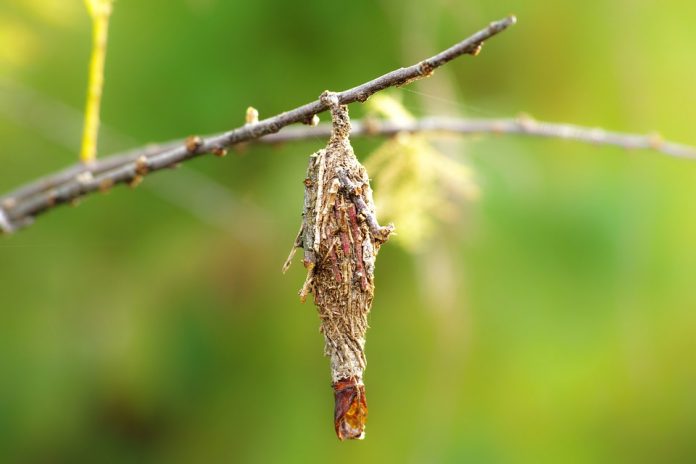This article talks about the bagworm moth caterpillar, which builds a cocoon around itself that looks like a log. The bagworm moth is a moth native to North America and some of the Caribbean. It has earned its name due to the cocoons it builds into bags within plant tissues.
The moth varies in size, but it is typically around an inch long. The Bagworm Moth has black hairs on its head and wings, yellow-white markings on its abdomen, black wings with white spots, and greenish-brown legs. Its antennae are white with black bands and dots at the end.

The bagworm moth caterpillar is a parasite whose larvae grow inside tree trunks and feed off of the roots. Bagworm moths are also known as “bagworms.”. The female bagworm moth lays eggs on twigs, branches, or leaves and then digs into the wood with her needle-like mouthparts to create a small chamber for the eggs to hatch in.
She will lay about 80–100 eggs over her lifetime, which could last up to 8 years. The pupae looks like a bag with legs attached to it, from which emerge adults that quickly break free from their cocoons. They are easily identified by their long antennae, which they can use to detect vibrations.
Bagworm moth is an insect that is usually found in old, warm, and humid spaces that are often neglected or ignored. Bagworms are small, brownish-gray insects that look like a smaller version of the stately gray tiger moth. They have a wingspan about 0.3 inches long; females weigh around 2 grams and males weigh around 1 gram.

It takes 10 to 15 years for them to grow up to their adult stage, after which they can reproduce with other members of the species. They also spread diseases through their body parts when they feed on silk storage moths. What exactly is a ‘Log House’-like cocoon of the bagworm moth? This is a term that refers to a type of caterpillar’s nest found on some trees.
The caterpillar larva builds it by hollowing out a circular space inside the trunk of the tree and secreting silken threads into the walls of its home. The silk-lined cavity is usually created at the end of a branch, and it gets funneled into the trunk, where it continues to grow in diameter.
The wall silk dries as soon as it is deposited and hardens instantly, providing an impenetrable barrier for any predators. It also provides great protection from rain and cold weather for the caterpillar larvae. Bagworm moths are small, brown, and tan-colored moths that have an interesting nest that they build by chewing on wood logs.

In the last few years, scientists have been able to use a laser to watch what happens inside the “Log House,” like the cocoon of the bagworm moth. The team has found out how these insects maintain a steady temperature inside their cocoons and make sure their offspring survive.
Bagworms make their nests using pieces of wood that they chew into 20–100 millimeters (0.8–4 inches) long fibers and chew again, making them into long strands about 2 millimeters in diameter. These strands are then tangled around each other, forming a thick web with a large central cavity in it that is filled with air.







